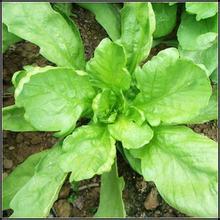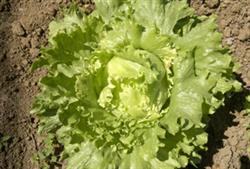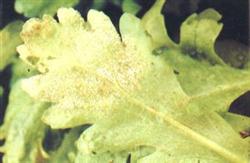High-yield cultivation techniques of Artemisia annua L. in greenhouse

Chrysanthemum chrysanthemum, also known as Artemisia annua, Chunju and Artemisia seed stalk, belongs to the genus Compositae and is a vegetable variety fed by tender stems and leaves. The growing period is short, and it can be harvested 40-50 days after sowing. This kind of vegetable has strong adaptability, strong cold tolerance and simple field management. it is an ideal variety for greenhouse to produce leafy vegetables in deep winter. Next, introduce the key points of high-yield cultivation of Artemisia annua in greenhouse. First, select superior species in the northern region generally choose Artemisia angustifolia, also known as Artemisia annua L. and Artemisia annua L. The leaf is pinnately parted, the leaf shape is fine, the mesophyll is thin, and the texture is hard. Tender stems and leaves are edible, with strong cold resistance, short growth period, strong aroma, deeply welcomed by vegetable farmers, very suitable for protected cultivation in the north. 2. 3000kg / mu of rotten farm manure, 50kg of calcium superphosphate and 50kg of ammonium bicarbonate are applied per mu before fertilization and soil preparation. Spread evenly on the ground, after deep ploughing, plough the border, the width of the bed is 1 to 1.5 meters, and tread lightly with your feet to prevent sinking after watering. Third, sowing seeds in a greenhouse at the right time, usually sowing in mid-December, so that it is easy to achieve higher economic benefits before the Spring Festival. Whether it is dry seed sowing or budding sowing, it can be divided into sowing and strip sowing. During strip sowing, ditches are opened in the border according to about 15 cm, and the ditch depth is 1 cm. Water in the ditch with a kettle, sow the seeds after the water seeps, and cover evenly with the soil from the ditch. After covering the soil, take out the topsoil from the adjacent border to be sown, and prepare for the next round of sowing. Fourth, post-broadcast management 1. Water and fertilizer management. Keep the border moist after sowing to facilitate seedling emergence. When the seedling height is 3 cm, the head is watered all over, and the whole growth period is watered for 2 or 3 times. When the seedling height is 912cm, the first fertilizer is applied, and the available nitrogen fertilizer is 1015kg per mu of water, and the total topdressing is twice. two。 Temperature management. The temperature can be slightly higher after sowing, 20 ℃ ~ 25 ℃ in sunny day, 10 ℃ at night, 15 ℃ ~ 20 ℃ in daytime and 8 ℃ ~ 10 ℃ at night after emergence, but high temperature injury must be prevented. When the plant has 1 or 2 true leaves, the seedlings begin to grow. It is appropriate to keep the seeding distance of 4 cm square, such as the method of strip sowing, it is necessary to sparse the seedlings that are too dense. 5. the main diseases of Artemisia annua are leaf blight, downy mildew and so on. In the early stage of the disease, 40% polysulfide suspension or 70% methyl topiramate wettable powder or 50% prohydantoin wettable powder 1500 times were sprayed. Once every 5 to 7 days, spray for 2 times in a row. 6. The harvest of Artemisia annua on the market can be divided into one-time harvest and phased harvest. One-time harvest is 40-50 days after sowing, the seedling height is about 20 cm, close to the ground to harvest. There are two methods of harvesting by stages: one is to harvest thinly, and the other is to keep 1 or 2 side branches. After each harvest, watering and topdressing once to promote the germination and growth of lateral branches, once every 20-30 days, the harvest yield per mu is 1000-1500 kg. It is best to finish harvesting during the peak demand period before the Spring Festival.
- Prev

Summer tube technology of heading lettuce
First of all, we should pay attention to fertilizer and water management. Due to high summer temperature, strong light, large ground evaporation and large crop transpiration, it is necessary to often water the soil at the initial stage of planting to keep the soil moist. Entering the rainy season from July to August, after each heavy rain, we should timely drain waterlogging and pour cold water to cool down in order to protect the leaves. Proper water control in the later stage of growth.
- Next

Cultivation and pest control techniques of Artemisia annua L.
First, field identification: Artemisia downy mildew can occur from seedling stage to adult stage. At the initial stage, the chlorotic macula with inconspicuous edge was produced on the leaves, the back of the disease spot was densely white to yellowish white mildew layer, and the diseased leaves withered rapidly. With the development of the disease, the adaxial surface of the diseased leaves is also densely white to yellowish white mildew layer. When it's serious.
Related
- Where is it suitable to grow horseradish in China? it is expected to see the middle altitude horseradish in Alishan.
- How to prevent tomato virus disease reasonably? (Control methods included)
- Many people like to plant towel gourd on the balcony. What are the main points of this method and management?
- What crops can chili peppers be mixed with?
- Fertilization techniques and matters needing attention in Tomato
- What are the grafting techniques for peach seedlings in spring?
- Harm and control methods of root swelling disease of Chinese cabbage
- What are the pests of sweet potatoes? How to prevent and cure it?
- Symptoms, causes and Control methods of navel Rot in Tomato
- The cause of "Cucumber rotten bibcock" in Farmers' planting Cucumber and its Control Plan

